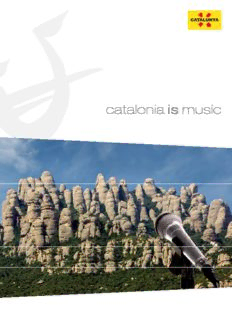
catalunya és música ANG PDF
Preview catalunya és música ANG
catalonia is music «Music, this wonderful universal language, should be a source of communication between all of mankind» Pau Casals © Generalitat de Catalunya Departament d’Innovació, Universitats i Empresa Gran Teatre del Liceu. Barcelona. In Catalonia, music and passion have always gone together. Their alliance began with the troubadours, evolved in the mediaeval monasteries, crossed the desert after the defeat of the secessionist uprising (La Guerra dels Segadorsor Reaper’s War), recovered with the coming of classical and contemporary music during the time of the 19th century Catalan cultural movement known as the Renaixença, flourished on a popular level with habaneras and sardanas, went into exile with Pau Casals after the Civil War, established ties later on during the dictatorship with European folk and re-emerged with the Nova Cançó (the New Song), expanded during democracy with Catalan rock and pop, and is now expressed in the electronic rhythms of the Sonar festival. Welcome to the sounds of Catalonia! Sephardic troubadours and romancers were already singing about the day-to-day life and sentiments of the Catalans when the County of Barcelona was established. Then came the mediaeval monasteries, the Escolania de Montserrat choir, plainchant with its sacred and profane polyphony during the Renaissance, and later, during the Renaixença, Catalan art and language made a recovery and classical music flowered in Catalonia with Albéniz, Mompou and Montsalvatge. These were followed by the cellist Pau Casals and the habanera and the sardana, with their substrate of popular dance and song; a legacy which has been given new life by mixing rhythms and fusing styles... Jazz and Nova Cançó with Serrat, Llach, Raimon, Tete Montoliu... Pop and folk, electronic music, rap and fusion with Estopa, Ojos de Brujo, Gerard Quintana and Els Pets, who draw the crowds now. And electronic rhythms triumph in cosmopoli- tan Barcelona every year at the numerous international festivals: Sonar, Primavera Sound, Summercase and so on. Today, Catalonia occupies a notable place on the classical and contemporary music scene: composers such as Guinjoan and Amargós, conductors such as Ros Marbà, singers such as Carreras, Aragall, Caballé and De los Ángeles, and institutions such as the Gran Teatre del Liceu, the Palau de la Música or the Orfeó Català confirm this. Choir in the basilica of Montserrat. Barcelona. The children’s voices of the Escolania de Montserrat choir, the oldest in Europe, are internationally acclaimed. Every day visitors can enjoy their performances of the Salveand the Virolai. Jaume Aragall. Pau Casals. Jordi Savall. Antoni Ros Marbà who scored the Catalan national anthem, Els Segadors; Frederic Mompou and his reinterpretation of Catalan traditional music; Pau Casals and his Cant dels Ocells; the clear, powerful voice of Jaume Aragall; Montserrat Caballé and the record-breaking twenty minutes’ ovation at the Barcelona Olympic Games after her duet with Freddie Mercury; the subtle voice of soprano Victoria de los Ángeles; Isaac Albéniz, Robert Gerhard, Enric Granados and his meeting with the impressionists; Eduard Toldrà and Xavier Montsalvatge; Josep Carreras singing for over twelve seasons with the legendary Herbert von Karajan; and Jordi Savall’s mastery of the viol. These figures confirm that Catalonia is music. Montserrat Caballé and Montserrat Martí. Josep Carreras. c a t a Val d’Aran France Andorra Pirineus Costa Brava Girona Lleida Catalunya Central Terres de Lleida Costa de Barcelona Maresme Costa del Garraf Barcelona Costa Daurada Tarragona Terres de l’Ebre Mediterranean Sea Catalunya l o n i a is music index Choral, early and religious 10 Classical and contemporary 12 Opera 18 Traditional and folk 20 Jazz and blues 24 Singer-songwriters 28 Catalan rumba and flamenco 30 Pop and rock 32 Independent, electronic and avant-garde 36 Musical venues 42 Museums, competitions and luthiers 44 Schools and conservatories 45 Points of interest 46 Useful addresses 48
Description: